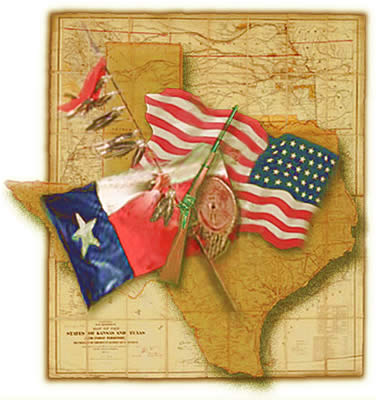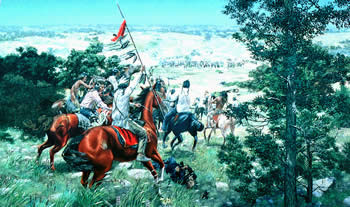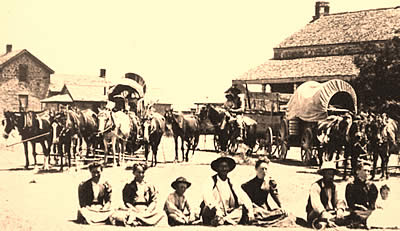Nineteenth-Century Forts and the Clash of Cultures on the Texas Frontier

- The Die Is Cast
- Texas and the Western Frontier
- U.S. Army on the Texas Frontier
- The Passing of the Indian Era
- Fort Griffin and the Prairie-Plains Frontier
- Fort McKavett and the Hill Country Frontier
- Fort Clark and the Rio Grande Frontier
- Fort Davis and the Trans-Pecos Trails
- Red River War
- Timeline for Texas and the Western Frontier
- Children's
Resources: Meet the People of Fort Griffin and The Flat!
- Teachers' Curricula
- Sponsors and Contributors
Scattered across the state from the Red River to the Rio Grande are the remnants of what was once a formidable military presence on the frontier—Texas' nineteenth-century forts. Some are ghostly ruins, others have been painstakingly reconstructed to evoke a sense of the lives that played out inside their walls. But these architectural artifacts are more than the nostalgic representatives of a romanticized period of American history. They are the visible reminders of the especially violent cultural conflict that erupted as lines of white settlement moved westward across the state into the domain of the Kiowas, Comanches, and other Plains Indians.
The forts and the frontier served as a proving ground for such great military commanders as Robert E. Lee and Quanah Parker. Buffalo hunters, gamblers, and entrepreneurs plied the scabtowns nearby. The sections that follow tell these and other stories, placing them in the context of the larger drama that attended a half-century of warfare between two ways of life that ultimately could not exist in the same land.
 As
the historian Robert Utley has explained, the Army faced problems in Texas
that it did not have elsewhere on the Plains, where its main challenge
was protecting white travelers on their way west. Texas posed that problem,
to be sure, but it had something else that presented an even graver issue:
two implacably hostile cultures whose settlements lay within striking
distance of each other. These elements of hearth and home gave the Texas
conflict an intensely personal character. For white and red peoples alike,
"Indian policy" was not a bureaucratic abstraction. It was life
filled with the daily prospect of an enemy at the door
As
the historian Robert Utley has explained, the Army faced problems in Texas
that it did not have elsewhere on the Plains, where its main challenge
was protecting white travelers on their way west. Texas posed that problem,
to be sure, but it had something else that presented an even graver issue:
two implacably hostile cultures whose settlements lay within striking
distance of each other. These elements of hearth and home gave the Texas
conflict an intensely personal character. For white and red peoples alike,
"Indian policy" was not a bureaucratic abstraction. It was life
filled with the daily prospect of an enemy at the door
The army defended three geographically distinct frontiers, as well as a transcontinental travel route through yet a fourth region. Each of these regions had unique attributes that shaped the army's mission and performance over time, and each in turn was shaped by the army's presence there.
Texas has had an almost symbiotic relationship with the military forces of the United States. Like so much of Texas history and culture, this has been largely a matter of geography. With a long international border and coastline, fear of foreign attack was a real concern of Texans for more than a century. But it was the special vulnerability of Texas' internal frontiers that most defined Texan's attitudes toward security in the last half of the 19th century. These web "exhibits" are a tour of the frontier conflict.
 To
begin your frontier journey, click on one of the headings above. The
Die Is Cast sets the tone and foreshadows the brutal conflict of
cultures in the state. Texas and the Western Frontier by Ty Cashion
and U.S. Military on the Texas Frontier by Robert Wooster each
provide overviews of the Anglo settlers determined westward journey and
the Army's role in protecting them. Sections on Forts McKavett, Griffin,
Davis, and Clark provide a more-detailed look at conflicts
in vastly different regions of the state, many of which stemmed from much
earlier rivalries and disputes among the various cultures. The narrative,
Passing of the Indian Era recounts the journeys and rivalries of
historic-period Indian groups in Texas, the near-destruction of their
cultures, and their eventual removal from the state. The Timeline
helps frame events on the Texas frontier era in a larger context.
"Meet the People of Fort Griffin and The Flat, " a children's
activity by Lisa Waller Rogers, provides a fascinating look at
the colorful characters in a Texas frontier fort and boom town. Specially
developed curricula for teachers has been correlated to the exhibits
above.
To
begin your frontier journey, click on one of the headings above. The
Die Is Cast sets the tone and foreshadows the brutal conflict of
cultures in the state. Texas and the Western Frontier by Ty Cashion
and U.S. Military on the Texas Frontier by Robert Wooster each
provide overviews of the Anglo settlers determined westward journey and
the Army's role in protecting them. Sections on Forts McKavett, Griffin,
Davis, and Clark provide a more-detailed look at conflicts
in vastly different regions of the state, many of which stemmed from much
earlier rivalries and disputes among the various cultures. The narrative,
Passing of the Indian Era recounts the journeys and rivalries of
historic-period Indian groups in Texas, the near-destruction of their
cultures, and their eventual removal from the state. The Timeline
helps frame events on the Texas frontier era in a larger context.
"Meet the People of Fort Griffin and The Flat, " a children's
activity by Lisa Waller Rogers, provides a fascinating look at
the colorful characters in a Texas frontier fort and boom town. Specially
developed curricula for teachers has been correlated to the exhibits
above.
Viewing and Navigation: To best view the Forts and Frontier "exhibits," follow the links in the order above. At any point, you can return to the Forts/Frontier Main page by clicking on the logo on the rust-colored bar near the top of the page.